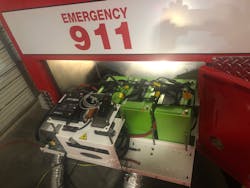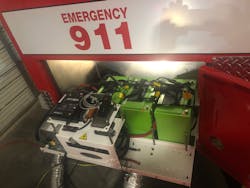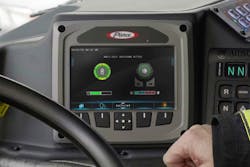The advancement of auxiliary power units improves apparatus fuel savings and emission reduction, but there are instances in which the systems’ implementation isn’t so cut and dried.
This is the case even though Firehouse Magazine and Argonne National Laboratory reported on them in 2017. Considering the long-term evolution of fire equipment, APUs remain a very recent addition. Currently, APUs aren’t covered by NFPA 1901: Standard for Automotive Fire Apparatus.
For fire apparatus, engine hours typically far exceed time on the road. Trucks, engines and rescues accumulate more hours standing still than they do in transit. For a good portion of that time, they aren’t engaged directly in firefighting. This is terribly fuel-inefficient and environmentally unsound. Although stations have seen improvements in environmental design, the fire service has done less to improve protection of our chauffeurs and operators who experience similar exposure.
That’s where APUs come into play, by independently powering warning lights and other critical vehicle systems while the main engine is off. Imagine the effect of idle-reduction technology (IRT) on task forces or greater alarms where the bulk of apparatus was called to bolster staffing and isn’t involved actively in suppression activity. Merit also can be found in APUs’ use during other incidents, such as blocking operations. (When the only requirement is for the rig to serve as a traffic control device, is it really necessary to consume fuel?) In fact, perhaps the greatest advantages emerge during nonfire events. Because the majority of runs are medical calls, apparatus typically sit idle from the time of arrival until return to quarters. In numerous cases, the duration is shorter than fire or extrication calls, but this is overshadowed by the sheer number of these emergencies. Because some departments also provide transport services, the same parameters apply to ambulances.
Undeniable benefits
As with any emerging technology, misconceptions and outright misinformation can obscure benefits and use. Perhaps a good analogy of APUs’ workings involves emergency power supplies that are used in fire stations and 9-1-1 centers. Here, active devices, such as motor-driven generators, and passive devices, such as uninterruptable power supplies, fill the need when commercial electricity is lost. Similarly, APUs come in diesel-driven and battery-powered models. Argonne National Laboratory’s research looked at both types and produced interesting results. However, because the fire departments that participated in the study utilized only diesel devices, the findings are limited. Nonetheless, the study results found that APUs consumed about 80 percent less fuel than a running apparatus and reduced maintenance and repair costs.
The study came to four conclusions:
- Emergency-response fleets that use IRTs not only save on fuel costs and reduce maintenance costs but also reduce emissions, noise and engine wear
- IRT systems must be well-matched to the fleet’s stationary power needs; HVAC needs will vary with region
- Fleets that use a single generation of a fully developed IRT system have better driver acceptance, less driver confusion and better return on investment than fleets that use various systems or various generations of a system
- Smaller, lighter and less expensive battery-powered APUs accelerate adoption
According to Harrison Hydra-Gen, which is a maker of power products, the reason that departments specify an APU varies.
“Some are looking just to check a box, some are looking at potential fuel savings, some are looking at reduced engine wear,” Paul Newton, who is the company’s vice president of sales and marketing, says. “There are also some departments that are forced to meet anti-idle regulations of the municipalities they serve.”
As a result, there is no one-size-fits-all approach when it comes to using an auxiliary power unit, Newton says. That said, APUs aren’t for everyone.
“There are times when an APU doesn’t make sense,” Newton adds. “For instance, smaller departments that have very few runs would not benefit from having an APU. Return on investment is simply not there.”
However, Newton says, not everything can be quantified in dollars and cents. “Sometimes it is environmentally responsible of the departments or municipalities to think of gains other than financial.”
ZeroRPM, which is the maker of what the company dubs “idle mitigation systems,” further clarified operational considerations in the vein of its engine-off electric power take off (ePTO) technology for hydraulic systems.
“ePTOs can be used in a variety of applications to replace the use of conventional PTOs,” ZeroRPM spokesperson Landon Self says. “The primary factor to consider with an ePTO is that, as the hydraulic load on the ePTO increases, this requires a higher amperage to supply power to the motor. This often translates to larger lithium-ion battery packs.”
Rosenbauer America says improvements in pollution control on propulsion systems as well as the current lower fuel prices are having an effect on the APU market.
When asked about common customer questions, a Rosenbauer America spokesperson says, “The biggest concern is the addition of more electronics and automation that is a change from the SOPs.”
Rosenbauer’s spokesperson went on to say that cost, complexity and space requirements are driven by the end needs. Systems range from $5,000–$30,000. These consist of batteries that address idle-reduction only, to engine-driven generators to supply scene lighting, alternating current power, and limited heating and cooling in the cab.Pierce Manufacturing has installed APUs in rigs since 2012. Eric Linsmeier, who is business unit director of electrical & software technology, says the APU market is maturing, which is good for the fire service because of improved and more affordable energy storage. “Currently, we are seeing about 4 percent to 5 percent [growth].”
Linsmeier went on to say that Pierce has evolved to include lithium-ion batteries.
“Many cities across the country have put initiatives into place to reduce emissions and fuel usage as a substantial way to support the health of the environment for residents,” Linsmeier tells Firehouse Magazine. “As a result, our customers are looking for solutions that reduce their carbon footprint, improve scene safety through noise reduction, extend the life of their product and reduce total cost of ownership.”
When it comes to APU performance, Linsmeier says lithium-ion batteries provide an improved load characteristic over a traditional lead-acid battery, which allows a fairly constant voltage output. “This is helpful when electrical loads from the fire apparatus are drawing from them.
“Additionally, lithium-ion batteries do not require regular maintenance, and they can recharge from a large range of discharge capacities without reducing their long-term performance,” he states.
According to Linsmeier, although warranties vary by supplier, lithium-ion batteries generally have a longer warranty coverage than a similar lead-acid battery.
The Redmond, WA, Fire Department, which is the department that’s featured in the 2017 Firehouse Magazine article, operates two Pierce engines and a ladder that utilize IRT. According to Brian Barrett, who is the department’s shop supervisor, there have been “no surprises thus far. We have seen less wear and tear on the vehicle’s main engine due to the fact that when the truck is at an accident scene or doing some inspection and the truck sits idling, [the APU] shuts down the engine after five minutes.”
“These fire trucks are driven hard every day to serve the public,” Barrett continues, “and since we have had this program going, we have had less trips to the dealer for warranty items and major engine break downs.”
Will the use of idle-reduction technology become widespread in the future? Only time will tell. After all, it wasn’t long ago that LEDs were unknown.
About the Author

Barry Furey
BARRY FUREY, who is a Firehouse Contributing Editor, provides consulting and training services in emergency communications. He is the former director of the Raleigh-Wake Emergency Communications Center in North Carolina. During his 50-year public safety career, he has managed 9-1-1 centers and served as a volunteer fire officer in three other states. In 2005, Furey received a life membership in the Association of Public-Safety Communications Officials (APCO) International for his continued work in emergency communications. Furey was inducted into the Firehouse Hall of Fame in 2017.


